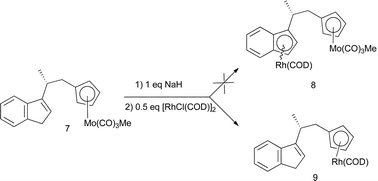Synthesis and reactivity of a cyclopentadienyl-indenyl ligand ring-coupled by a chiral bridge derived from ethyl (S)-(−) lactate†
Abstract
In order to prepare a new unsymmetrical chiral

* Corresponding authors
a
Aix Marseille Université, CNRS, iSm2 UMR 7313, Marseille, France
E-mail:
richard.lai@orange.fr
b Laboratoire de Chimie de Coordination, 205 route de Narbonne, 31077 Toulouse Cedex 04, France
c Centrale Marseille, Aix-Marseille Université, CNRS, iSm2 UMR 7313, Marseille, France
In order to prepare a new unsymmetrical chiral

 Please wait while we load your content...
Something went wrong. Try again?
Please wait while we load your content...
Something went wrong. Try again?
R. Laï, J. Daran, D. Nuel, M. Sanz, N. Summerton, N. Vanthuyne and A. Zaragori-Benedetti, Dalton Trans., 2013, 42, 7980 DOI: 10.1039/C3DT33019B
To request permission to reproduce material from this article, please go to the Copyright Clearance Center request page.
If you are an author contributing to an RSC publication, you do not need to request permission provided correct acknowledgement is given.
If you are the author of this article, you do not need to request permission to reproduce figures and diagrams provided correct acknowledgement is given. If you want to reproduce the whole article in a third-party publication (excluding your thesis/dissertation for which permission is not required) please go to the Copyright Clearance Center request page.
Read more about how to correctly acknowledge RSC content.
 Fetching data from CrossRef.
Fetching data from CrossRef.
This may take some time to load.
Loading related content
